Last week, we tackled the first sixteen potential Commanders from Phyrexia: All Will Be One. Today, we’ll be continuing our journey through the Spheres with the remaining dozen—one for each color pair, one four-color monstrosity, and the sole artifact. The monocolored Legends were a mix of Limited bombs, archetype enablers, splashy Commander slam dunks, and Geth. This week, we’ll see how the multicolored cards measure up.
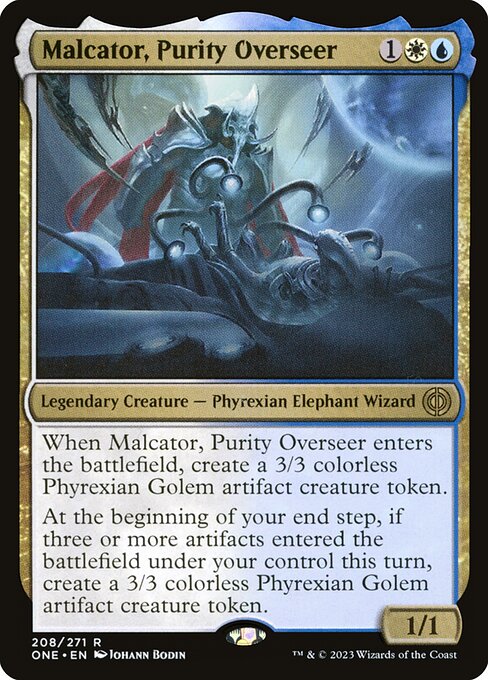
Malcator, Purity Overseer—Starting off with a flicker instead of a bang, Malcator asks that you jump through well-explored hoops in order to get a vanilla 3/3 or two. While it’s relatively easy to Ephemerate your way to an army of Golems, there’s no real reason to do so with the Phyrexian Elephant instead of Brago, King Eternal or Roon of the Hidden Realm other than a) boredom with these hoary old generals or b) Golem synergy. If you want to try something new, though, Malcator can produce a steady flow of Golems—try Cloudstone Curio and two zero-mana artifacts, or simplify things by bouncing Ancestral Statue to its own ability with a Mycosynth Golem in play.
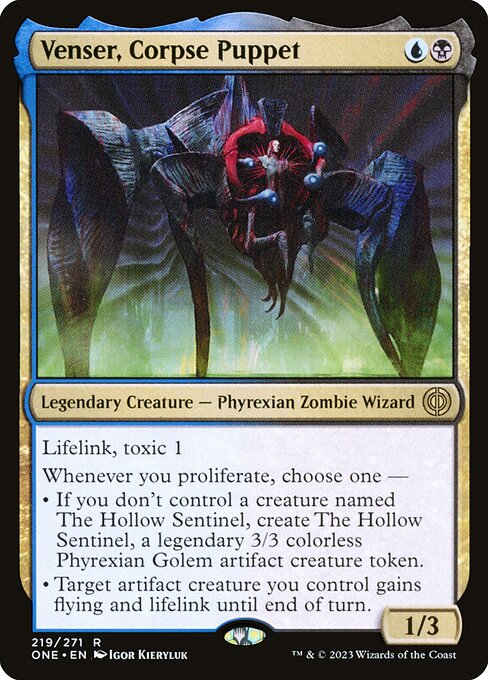
Venser, Corpse Puppet—Phyrexia’s existence is predicated upon desecration. From the earliest days of Magic, it’s been a hellish landscape of screaming metal, toxic rains, and mutilated undead. Phyrexia chews up organic material—human carcasses, the environment, apex predators—and converts them into perverse metallic simulacra of their former shapes. So it’s not a surprise to see Venser zombified, corrupted and ceaselessly creating noxious copies of his former allies, but it does up the stakes significantly. Here, Wizards is telling us, is what awaits all of Magic’s characters if the Phyrexian assault succeeds.
From a mechanical standpoint, Venser is a jack of all trades, gaining a single point of life and passing out a single poison counter, with the ability to boost our artifact creatures or create one in a pinch. His best friends, aside from Karn, are Walking Ballista, Blightsteel Colossus and Triskelion, not that they need the help. If you want to combo out, Throne of Geth and Dross Scorpion (plus any Blood Artist or Altar of the Brood effect) comprise a loop. While that’s a decent base for the average combo player, I’d rather build around the synergy between Venser and Cyclonus, the Saboteur. The Cybertronian saboteur is a solid proliferate target, helping you to meet that 5-power qualifier, and the additional beginning phase it grants you will untap your Throne of Geth or other essential cog. Plus, it helps lighten the sting of seeing Venser’s corpse turned into a sick marionette when we can imagine him at the helm of a robot jet plane.
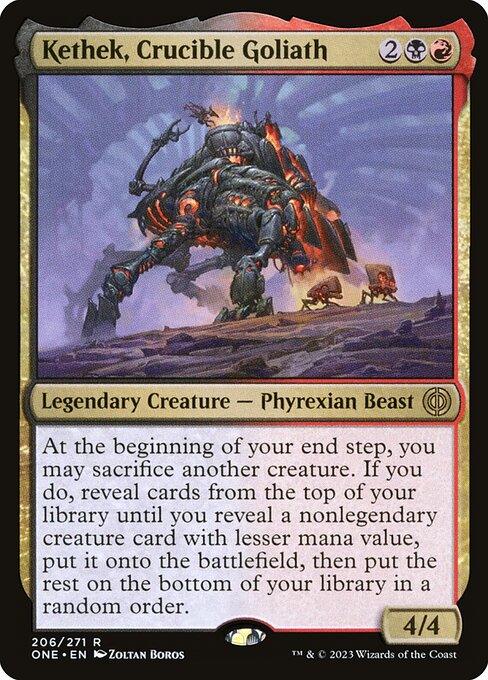
Kethek, Crucible Goliath—Sacrificing your own creatures to Kethek is all well and good, but it’s much better when you can sacrifice your opponents’. There are numerous ways to do so, from Captivating Crew to the humble Hijack, but for flavor reasons, I’m drawn to Ritual of the Machine. While it’s one-shot, there’s something very demoralizing about having your creature sniped by a mono-black spell. A Kethek deck will be running a slate of disposable creatures that scale down the chain—sacrificing Bloodghast to find a Gravecrawler may be dull, but it does work—so I’m drawn to Mercadian Masques’ Mercenaries. There are 38 Mercenaries available to us in Rakdos, of which about four are playable if you squint, but one of those is Moggcatcher, so perhaps Kethek is build-your-own-reverse-Birthing-Pod with a Goblin subtheme.
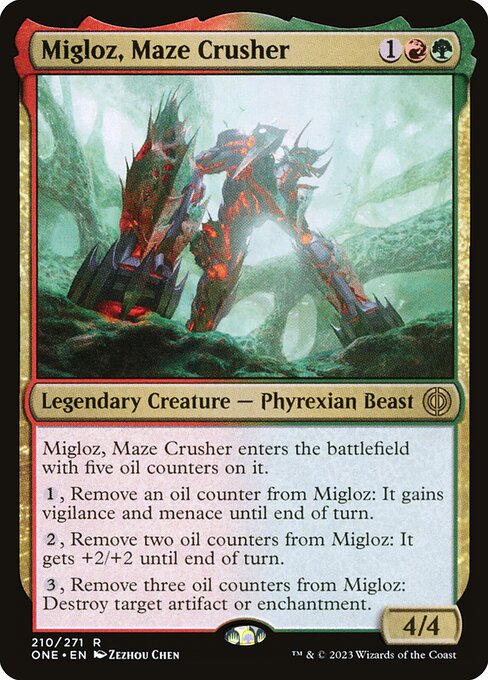
Migloz, Maze Crusher—Limited bomb, to be sure, but not terribly exciting as the Commander for a Gruul deck. Contaminant Grafter and Kodama of the West Tree help Migloz trample through and get value, but it’s an undersung card from New Capenna that provides support for Migloz: Park Heights Maverick. A single-card Proliferate engine, the Maverick hasn’t gotten its due respect in the year since its printing. But the little Art Deco anarchist grows steadily as a threat and can Proliferate periodically—no Thrummingbird, maybe, but an interesting backup Bloated Contaminator and a counterpart to Migloz.
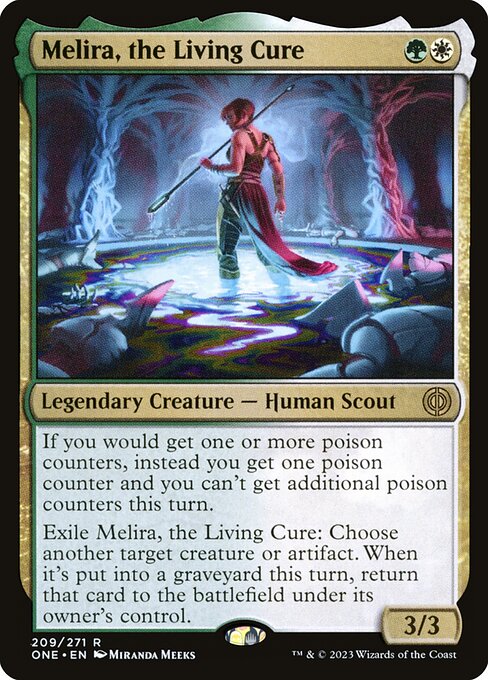
Melira, the Living Cure—A plant for Constructed, the anti-Toxic Watchwolf doesn’t inspire any immediate creative decks, particularly since we’ve had Saffi Eriksdotter for years. That said, it’s Melira’s “you can’t get additional poison counters this turn” ability that I’m most enthused about. Selesnya doesn’t give us any ways to self-poison for any benefit, but I’m a proponent of Sending Them A Message, so I’d pair Melira with Walking Ballista, Enduring Renewal, Ashnod’s Altar, and Grafted Exoskeleton. Melira allows you to protect any component of this combo on the fly, as well as prevent Infect damage in case you want to throw some of those Ballista counters at yourself. Why? For the same reason any act of mithridatism eventually turns into a party trick—if you can swallow poison without any harm to yourself, why wouldn’t you demonstrate that ability?
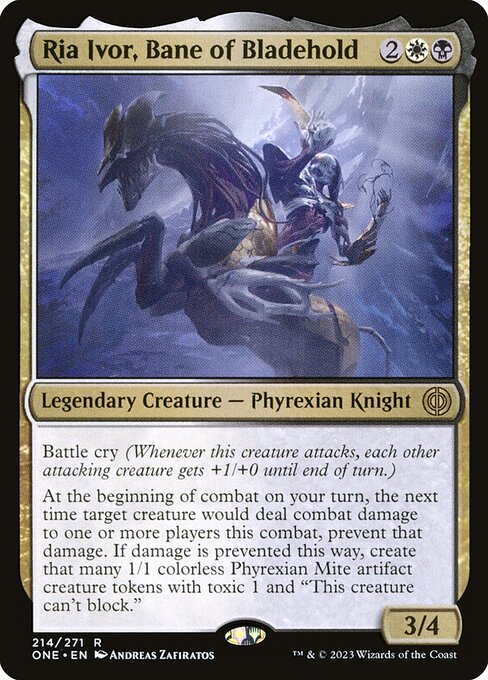
Ria Ivor, Bane of Bladehold—What Ria asks of us is simple: a hard-to-block creature with high power to turn into a horde of Mites. In Black and White, this isn’t easy to find without a drawback, but Ria can run cards like Demon of Catastrophes, Dust Elemental, Master of the Feast, or even Phyrexian Dreadnought to start cranking out Mites early. You could also go the opposite direction and run cheap, resilient threats to start making Mites early, from Adanto Vanguard to Arco-Flagellant to Kytheon, Hero of Akros to Seasoned Hallowblade. Whichever direction you take, though, Westvale Abbey should be one of your destinations—in a Mite-producing deck, it’s easy to flip, and can be your Ria target to create up to nine Mites a turn.
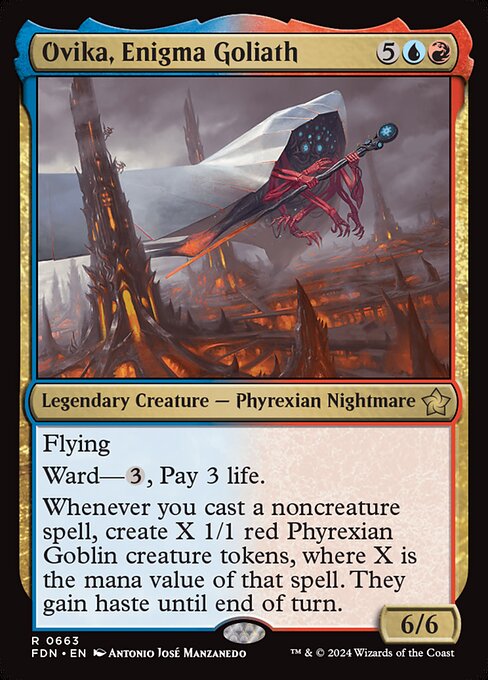
Ovika, Enigma Goliath—A beautifully strange, perhaps even enigmatic card, Ovika asks that we a) run expensive spells in Izzet colors and b) care about Goblins. For those of us who have been playing Magic for decades, this means one thing: Goblinstorm. Suspend a stack of spells, time them so Ovika is out, and then cast a flurry of Rituals and close with an Empty the Warrens. That’s the immediate thought, but we don’t have to be tied to Battle Hymn into a haymaker: instead, we can pair Ovika with Ethereal Forager or, more interestingly, with Octavia, Living Thesis. There’s a Delve deck that Ovika could helm, with Forager and Murktide Regent, Dig Through Time, and Temporal Trespass. Add Faithless Looting and Burning Vengeance and some self-mill and beneficial discard, and you have an Ovika deck that churns through its deck and chews through its graveyard—very on-brand for the Phyrexian oddity.
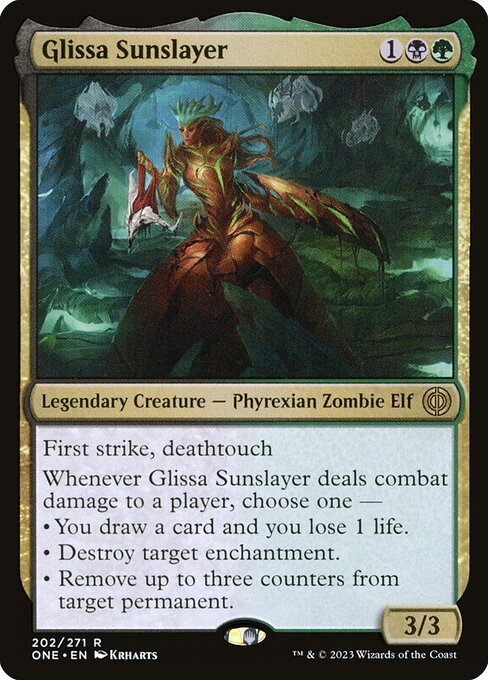
Glissa Sunslayer—A riff on Mirrodin Besieged’s Glissa, the Traitor, Sunslayer keeps the stats intact as a 3/3 for three with the potent combo of First Strike and Deathtouch. Rather than enabling an Executioner’s Capsule loop, though, this new Glissa is more open-ended and generic. She could be an Elf deck commander, an Enchantress Commander, or a Voltron Commander—or, in my hands, she could be something much sillier. That Hex Parasite-ish counter removing ability called to me, and led to a single idea: Dark Depths. More specifically, I wanted to see how many copies of Marit Lage I could create, so I built a Golgari Lands deck that recurred Depths with Crucible of Worlds or Ramunap Excavator. Hex Parasite, Vampire Hexmage, Thespian’s Stage, and Mirror Box rounded out the deck, with Glissa as a backup way to shave counters off a Dark Depths. It’s a blast to play, particularly once you have a Marit Lage for each opponent.
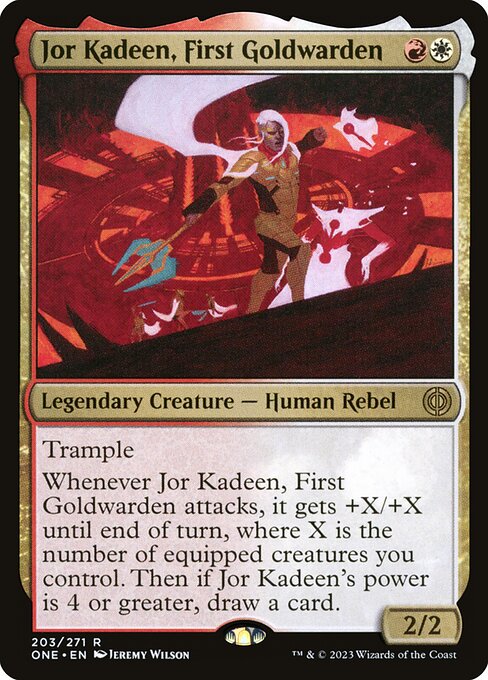
Jor Kadeen, First Goldwarden—Sometimes, Wizards throws us a Commander that is as blunt an instrument as it gets. “Play Boros cards that care about Equipment,” says Jor Kadeen, “and lots of them.” There’s not much else of an angle on this guy, honestly, but he’s exceptional with a Bloodforged Battle-Axe. No need to reinvent the warhammer—just run Toggo, Goblin Weaponsmith, Wyleth, Soul of Steel, Balan, Wandering Knight, you know the drill. I would note that, at this point, we have enough Boros “Equipment matters” Legends to populate an entire deck—as we get more Legendary synergy, this may become important. I like the concept of a deck full of nothing but brawler Legends, a warrior party that’s loaded up with weaponry and ready for anything. I don’t see Jor Kadeen at the head of this deck—rather, I’d start with Dihada, Binder of Wills and move from there.
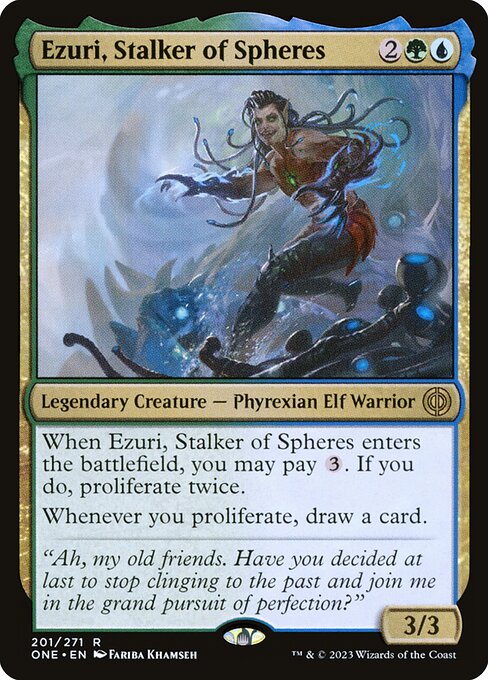
Ezuri, Stalker of the Spheres—It’s hard to stray away from Proliferate with Ezuri, so we won’t, but we will take it in a different direction: Nekusar-style Burn with Malignant Growth. Add Deepglow Skate and Vorel of the Hull-Clade to really ramp things up and Power Conduit (or our friend Tekuthal) to siphon off the age counters to keep the Cumulative Upkeep low, and you have the shell of a profoundly silly deck.
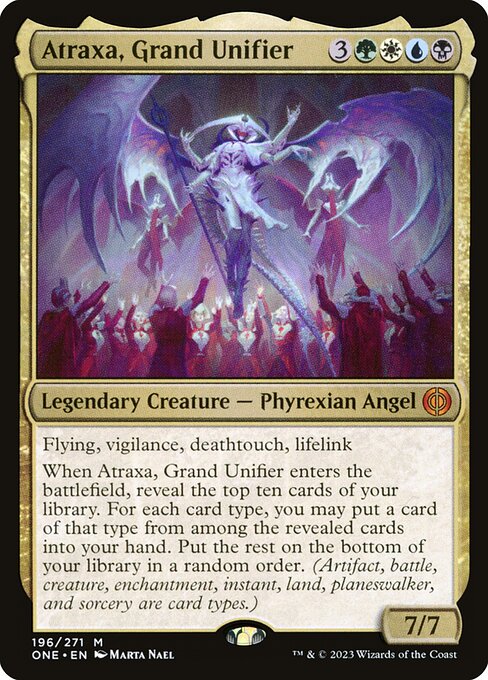
Atraxa, Grand Unifier—Your standard Atraxa list is going to be a blink-based goodstuff deck that flickers the Commander to draw a grip of cards. That’s all well and good, but we can make the Phyrexian Angel a weirder card that your usual Conjurer’s Closet or Teleportation Circle fodder by playing into her beefy mana value and type-hunting ability with Not of This World. Atraxa gets you value from hitting the field, but is also a battler par excellance, particularly if you can protect her. NoTW lets you do so for free and ideally off of her battlefield trigger. Sure, you could use Fierce Guardianship, but you could also use a little style and get a protection spell as your Tribal pull.
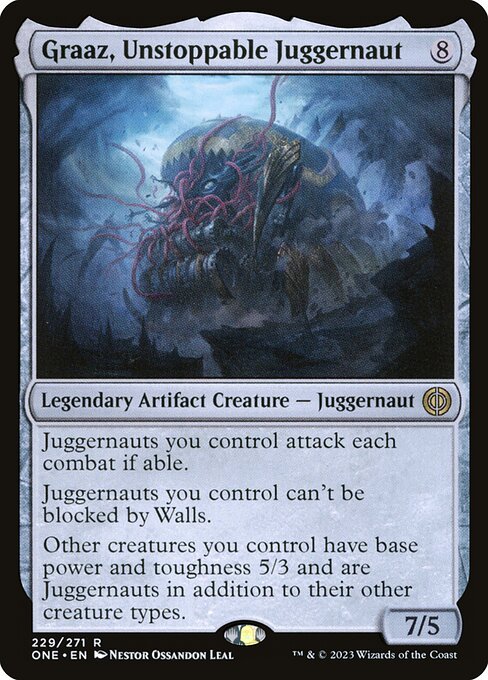
Graaz, Unstoppable Juggernaut—To close us out, we have the Legendary Leveler, and we’ll close as we began: with a unique spin on tokens. Since we’re already trying to ramp up to an eight-mana Commander, we might as well embrace the swarm with Skittering Invasion and Spawning Bed. Being colorless does limit our token-producing options—Canoptek Scarab Swarm, Clown Card (Rule Zero caveat), Inquisitorial Rosette, Mascot Exhibition, Shrine of Loyal Legions, Summoning Station, and Thunderhawk Gunship are our best options. Field of the Dead will also produce Zombienauts for us, since we’re probably running the usual suite of colorless lands. But it’s a one-time Standard combo finisher that calls to me for Graaz, since they’re a reference to original Mirrodin, now two decades old: Myr Incubator. Manuel Bevand took a Myr Incubator deck to a 6-0 finish back in 2004—he would power out an Incubator with the usual Chrome Mox/Krark-Clan Ironworks acceleration, and then exile the majority of his deck, which was two-thirds artifacts, to pop out a couple dozen Myr tokens. Mirrodin Standard was a wild time, and we can hearken back to it with our Juggernaut lord.
Suitably enough, Graaz finishes our through Phyrexia: All Will Be One’s potential Commanders, much as Memnarch’s Levelers used to pave over the obsolete portions of Mirrodin. It’s been quite a run—Wizards has been on a Legendary kick for a decade plus now, but since the start of 2022, they’ve printed 144 Standard-legal Legendary Creatures, from Ao, the Dawn Sky to Zur, Eternal Schemer, and 427 total Legendary Creatures since Kamigawa: Neon Dynasty.
I’d say not every Legend is worthy of a Commander deck built around them, but isn’t that the appeal of Commander? That someone has been drawn to every Legend, no matter how mundane, no matter how overcosted or underpowered, and has chosen to build a deck to showcase them? Commander is a format of self-expression, a format that uses the tools you have access to, a format that embraces restrictions—whether in the rules of the format or self-imposed. There are more Legends now than ever, and that means some of them suffer in terms of creative or powerful designs, and yet, when we consider each Legend, no matter how mundane, we see the full scope of this game and its meaning.
Rob Bockman (he/him) is a native of South Carolina who has been playing Magic: the Gathering since Tempest block. A writer of fiction and stage plays, he loves the emergent comedy of Magic and the drama of high-level play. He’s been a Golgari player since before that had a name and is never happier than when he’s able to say “Overgrown Tomb into Thoughtseize,” no matter the format.

